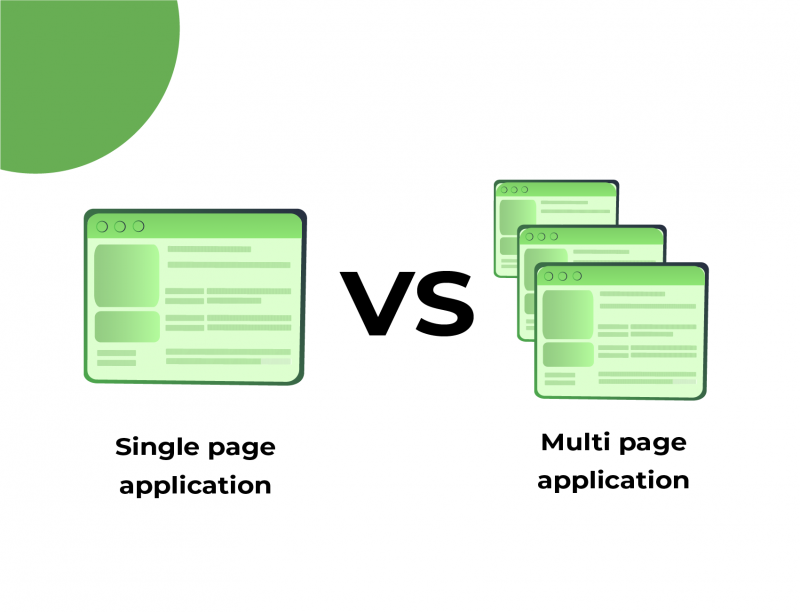Looking for the best way of building a website, you’ll definitely face two well-known approaches and will have to choose between MPAs (Multi-page applications) and SPAs (Single-page applications). You may apply a hybrid approach as well, using the host one or rich SPA-like sub-apps within a larger web application.
Even though Single Page Apps are considered to be more innovative and highly demanded, it is worth considering MPAs as they provide a range of real advantages. Selecting between these two ways, it’s important to remember about business goals and how they can be realized with your particular development approach. In this article, we define the key pros and cons of Single-Page and Multi-Page solutions.
Contents
What is an SPA? Single-Page Application definition
An SPA is a solution that works inside a browser. It does not require page reloading during its use. If you cannot remember the evident examples of every-day using these apps, just recall Facebook, Gmail, Google Maps, Trello, or Hygger.
Single Page Applications utilize AJAX and HTML5. JS frameworks (React, Angular, Vue, and Ember) are responsible for processing the heavy challenges on the client-side for SPAs.
Such apps let users stay in one cozy web space where content is reflected in a workable and convenient form.
Single-Page Applications advantages
- The development process of Single-Page Applications is friendly and simple. No need to write code to render pages on the server.
- They perform fast, as most resources are only loaded once throughout the lifespan of the application.
- They are easy to debug with Chrome.
- Developers can reuse code.
- SPAs can effectively cache any local storage.
- Single-Page Applications can work offline.
Single-Page Application disadvantages
- SPAs can damage SERP ranking. SPAs have just one page, so their ranking is affected. For example, with a single page, you can’t put more than a limited number of keywords.
- Disabled JavaScript can hinder proper functioning of the app.
- Navigation is not so easy.
- Cross-site scripting can pose a serious security threat during SPAs development.
- Space constraints. With just one page to deliver your content, adding more to it can be really difficult.
- Browser history. A browser only takes users to the previous page, not to the previous state in an app.
What is an MPA? Multi-Page Application definition
An MPA is a web application that includes more than one page and needs to reload the entire page (even for loading a small icon on a web page).
In comparison to Single-Page Applications, MPAs look large and complicated to develop. Looking for examples, just think about Amazon, eBay, or any other complex site with multiple pages.
Multi-Page Applications work in a traditional way. They are extremely large out of necessity. MPAs usually consist of a big amount of content so they generally have many levels and various links. They may also include many micro-websites and subsections inside.
Multi-Page Applications advantages
- Multi-Page Applications may include as much product info as required, without page limitations. They allow creating new content and placing it on new pages easily.
- These apps are good and easy for proper SEO management. There are more chances to rank for different keywords, as such apps can be optimized for one keyword per page.
- They suit better users who need a visual map of where to go with clear menu navigation.
- These solutions usually provide lots of analytics and data about how a website is performing.
- Their initial page load is faster.
- Thanks to the profusion of established technologies and developers working in the same domain, MPA development has become a cost-effective approach.
- Finally, most of the frameworks available for MPA have been tested over time, which makes them more secure.
Multi-Page Applications disadvantages
- Loading time increases.
- Performance speed decreases.
- The development process related to MPAs may become rather tedious because of tight coupling between the front end and the back end parts.
- Mobile development becomes difficult as, unlike in SPAs, there is no opportunity to use the same back end code.
- Testing gets rigorous, as there are no clear distinctions between User Interface and data.
- Maintaining security may become a real challenge because developers have to secure each separate page.
MPA vs SPA: How to make a proper choice?
Both MPA and SPA architectures have their evident benefits and potential disadvantages and risks.
- Single-Page Applications become more and more popular because of their speed and the ability to develop a mobile app based on the ready-made code. However, poor SEO optimization may be a barrier for many people. SPAs are good for SaaS platforms, closed communities, social networks, where SEO does not really matter.
- Multi-Page Applications look more appropriate for online stores, catalogs, business sites, marketplaces, etc. They have high performance but still do not allow you to develop a mobile app painlessly.
The choice between an SPA and an MPA can be easier when you have your goals and requirements ascertained. What do you think about this difference? What architecture do you prefer?





